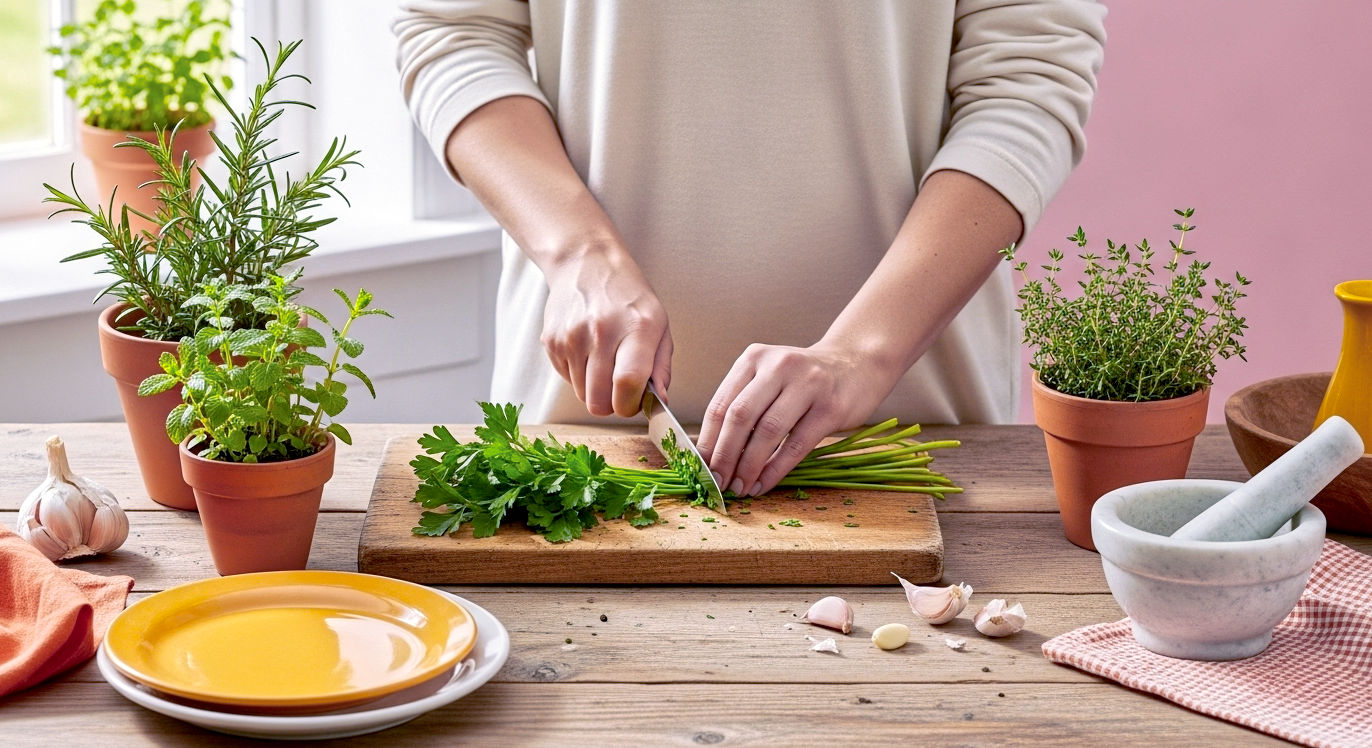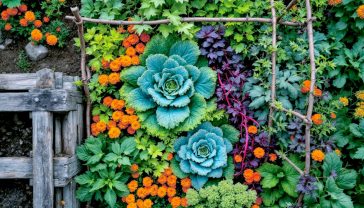Herbalicious Delights: The British Guide to Cooking with Fresh Garden Herbs
The definitive UK guide to cooking with fresh herbs. Learn how to chop, pair, and preserve garden classics to transform your everyday meals from bland to brilliant.

This post may contain affiliate links. If you make a purchase through these links, we may earn a commission at no additional cost to you.
There’s a kind of magic that happens when you cook with fresh herbs. It’s the fragrant burst of rosemary as it hits a hot pan with roast potatoes. It’s the cool, clean scent of mint you chop for a salad. It’s the vibrant green of parsley that lifts a simple fish dish from everyday to outstanding. For too long, we’ve seen herbs as a bit of fancy garnish—a token green leaf perched on top of a meal. But they’re so much more than that.
Fresh herbs are the heart and soul of good cooking. They’re flavour, aroma, and colour all rolled into one. They can transport a boring Tuesday night chicken dinner to the sunny Mediterranean or make a Sunday roast feel even more like a British institution. And the best part? You don’t need to be a Michelin-starred chef to master them.
This guide is your ticket to becoming a confident, creative herb user. We’ll take you from being a hesitant sprinkler to a herb-chopping, flavour-pairing champion. We’ll explore the essential herbs for any British kitchen, show you how to prepare and use them, and even give you tips on growing your own, whether you’ve got a sprawling garden or a tiny city windowsill. Forget dusty jars of dried herbs at the back of the cupboard; let’s unlock a world of fresh, vibrant flavour that’s waiting right at your fingertips.
A Potted History: How Herbs Shaped the British Kitchen
Our love for herbs isn’t a new foodie trend; it’s woven into the very fabric of our history. When the Romans marched into Britain, they didn’t just bring roads and central heating; they brought their seeds. They introduced herbs like rosemary, thyme, and parsley, not just for flavouring their food and wine but also for their medicinal properties.
After the Romans left, it was the monks who became the custodians of herbal knowledge. In their quiet monastery gardens, they carefully cultivated herbs for healing potions and to make their simple, often bland, food more palatable. These gardens were the original pharmacies and spice racks of Britain.
The Tudor and Elizabethan eras saw a huge boom in the use of fresh herbs. Grand houses had sprawling, intricate kitchen gardens, and no dish was complete without a generous scattering. Herbs were used to flavour meats, preserve foods, and even to ‘strew’ on the floor to mask unpleasant smells. But as centuries passed and global trade brought exotic dried spices from faraway lands, our humble garden herbs fell out of fashion.
The 20th century, particularly after the Second World War, saw a further decline. Convenience food was king, and a jar of dried mixed herbs was about as adventurous as it got for many households. But thankfully, a renaissance was just around the corner. Chefs and food writers in the late 20th century, from Elizabeth David to modern heroes like Jamie Oliver and Nigel Slater, reminded us of the incredible, punchy flavours we were missing. They championed fresh, seasonal, and local produce, and at the very top of that list were fresh garden herbs. Today, they’re back where they belong: at the centre of the British kitchen.
Meet the Classics: The Six Essential British Garden Herbs
If you’re starting your journey with fresh herbs, you can’t go wrong with these six champions. They are reliable, versatile, and perfectly suited to the British climate and palate. Think of them as your herbal starter pack.
Parsley: The Unsung Hero
Often dismissed as a mere garnish, parsley is one of the most useful herbs you can have. It has a clean, bright, and slightly peppery flavour that lifts and balances other ingredients without overpowering them. It makes everything taste fresher.
- Flat-Leaf vs. Curly: You’ll find two main types. Flat-leaf parsley (sometimes called Italian parsley) has a more robust, peppery flavour and is generally preferred by chefs for cooking. Curly parsley is milder and its frilly texture makes it a classic garnish, but don’t be afraid to chop it into salads for a bit of crunch.
- Flavour Profile: Fresh, grassy, and clean with a peppery kick.
- Perfect Pairings: It’s brilliant with fish, chicken, and eggs. It’s the star of a classic parsley sauce for ham or fish, and it’s fantastic stirred through potatoes, pasta, or rice. It also forms the base of many sauces, like Italian salsa verde and Middle Eastern tabbouleh.
- Top Tip: Don’t throw the stalks away! They are packed with flavour. Add them whole to stocks, soups, and stews (just remember to fish them out before serving) for an extra depth of flavour.
Mint: The Great Refresher
Is there any aroma more refreshing than freshly crushed mint? It’s the smell of summer, of Pimm’s on the lawn and fresh mint tea after a big meal. It’s an incredibly vigorous plant, so much so that it can quickly take over a garden if you’re not careful.
- Spearmint vs. Peppermint: The most common variety for cooking is spearmint, which has a sweeter, more delicate flavour. Peppermint is much more pungent and contains more menthol, making it better for teas and confectionery.
- Flavour Profile: Cool, sweet, and wonderfully aromatic.
- Perfect Pairings: The classic British pairing is, of course, with lamb. Mint sauce is a non-negotiable part of a roast lamb dinner. It’s also wonderful with new potatoes and peas. In drinks, it’s essential for a Pimm’s Cup or a mojito. It also works surprisingly well in fresh fruit salads.
- Top Tip: Mint is a bully in the garden. Always plant it in a pot (even if you sink the pot into the ground) to stop its roots from spreading everywhere and taking over your entire garden patch.
Rosemary: The Fragrant Powerhouse
This hardy, woody herb is like a little piece of the Mediterranean in a British garden. Its strong, fragrant needles can stand up to long cooking times, infusing dishes with their incredible aroma.
- Flavour Profile: Piney, woody, peppery, and intensely aromatic. A little goes a long way!
- Perfect Pairings: Another herb that has a famous partnership with lamb. Stabbing a leg of lamb with slivers of garlic and sprigs of rosemary before roasting is a British classic. It’s also the perfect partner for roast chicken and potatoes. A few sprigs thrown into the roasting tin will make your spuds taste incredible. It’s also used to flavour breads like focaccia.
- Top Tip: The woody stems are too tough to eat, but they are full of flavour. Use a sturdy rosemary stem as a natural, fragrant skewer for kebabs. As the food cooks, the heat will release the rosemary’s essential oils, flavouring the meat or vegetables from the inside out.
Thyme: The Subtle Workhorse
Thyme is one of the most versatile and hard-working herbs in the kitchen. Its flavour is more subtle than rosemary’s, making it a brilliant team player that enhances everything from rich stews to delicate chicken dishes.
- Varieties: Common thyme is the go-to, but look out for lemon thyme, which has a wonderful citrusy scent and is fantastic with fish and chicken.
- Flavour Profile: Earthy, savoury, slightly floral, and peppery.
- Perfect Pairings: It’s essential in stocks, stews, and soups. It’s wonderful with roast meats (especially chicken), mushrooms, and root vegetables. It’s a key ingredient in a classic bouquet garni (a bundle of herbs used to flavour stocks and casseroles).
- Top Tip: To get the tiny leaves off the woody stem easily, simply hold the top of the sprig with one hand and run the fingers of your other hand firmly down the stem from top to bottom. The leaves should pop right off.
Sage: The Sunday Roast Staple
With its soft, velvety, grey-green leaves, sage has a unique and powerful aroma that just smells of comfort cooking. Its strong flavour means you don’t need to use much, but when used correctly, it’s magnificent.
- Flavour Profile: Highly aromatic, musky, and peppery with hints of eucalyptus and lemon.
- Perfect Pairings: Sage and pork are a match made in heaven. It’s the key flavour in classic pork and apple sausages and is essential for a good sage and onion stuffing for your Sunday roast chicken or turkey. It’s also beautiful in Italian dishes; a simple pasta with brown butter and crispy sage leaves is a true delight.
- Top Tip: Frying whole sage leaves in a little butter or oil until they are dark green and crispy is a game-changer. They become nutty and crunchy. Sprinkle them over pasta, risotto, or roasted squash for a fantastic texture and flavour boost.
Chives: The Gentle Onion
Chives are the most delicate member of the onion family. They provide a mild, fresh oniony hit without the aggressive bite of a raw onion or the pungency of garlic. They are best used raw or added at the very last minute to preserve their delicate flavour.
- Flavour Profile: A mild, fresh, and gentle onion flavour.
- Perfect Pairings: They are perfect with eggs—sprinkled over scrambled eggs or an omelette, they add a fresh lift. They are the classic partner for a baked potato with sour cream. They are also wonderful snipped into salads, salad dressings, and potato salads, or used as a garnish for soups and fish dishes.
- Top Tip: Never chop chives with a knife as it can bruise them and make them mushy. Instead, use a pair of kitchen scissors to snip them cleanly. This keeps them looking and tasting their best.
Venturing Further Afield: Expanding Your Herbal Horizons
Once you’ve mastered the classic six, it’s time to get a bit more adventurous. These herbs bring flavours from around the world to your kitchen.
- Basil: The sweet, peppery taste of Italy and summer. It’s delicate and hates heat, so always add it at the end of cooking. It’s the heart of pesto and the perfect partner for tomatoes, mozzarella, and garlic.
- Coriander: You either love it or you hate it! For those who love it, its pungent, citrusy flavour is essential in Mexican, Indian, and South-East Asian cooking. Use both the leaves and the stalks (which have an even stronger flavour) in curries, salsas, and salads.
- Dill: With its feathery fronds and anise-like flavour, dill is hugely popular in Scandinavian and Eastern European cuisine. It’s the perfect partner for salmon and other fish, and it’s wonderful in cucumber salads, yoghurt dips, and with potatoes.
- Oregano: The “pizza herb.” This is one of the few herbs whose flavour is arguably more intense when dried. Fresh oregano is more pungent and peppery. It’s a staple in Greek and Italian cooking, pairing beautifully with tomatoes, aubergines, lamb, and roasted vegetables.
- Tarragon: The star of French cooking. Tarragon has a distinctive, sophisticated flavour that’s a bit like aniseed. It’s the key ingredient in a classic Béarnaise sauce and is absolutely beautiful with chicken and eggs. A simple roast chicken with a few sprigs of tarragon tucked inside is a revelation.
The Cook’s Know-How: Mastering a Herbfresh-ional’s Skills
Knowing which herb to use is one thing, but knowing how and when to use it is what really makes the difference.
The Soft and the Hard of It: When to Add Your Herbs
This is the golden rule of cooking with herbs. It’s all about their texture.
- Hard Herbs: These are herbs with tough, woody stems and robust leaves, like rosemary, thyme, sage, and oregano. They can withstand long cooking times, and in fact, they need the heat to release their full flavour. Think of them as marathon runners. You should add them at the beginning of the cooking process, such as when you’re sautéing onions for a stew or rubbing them onto a roast before it goes in the oven.
- Soft Herbs: These are herbs with tender stems and delicate leaves, like parsley, basil, coriander, mint, chives, and dill. They are sprinters, not marathon runners. Their fresh, delicate flavours are destroyed by heat. You should add them at the very end of cooking or use them raw. Stir them into a dish just before serving, or sprinkle them over the top as a final flourish.
From Garden to Plate: Washing and Prepping
Herbs from the garden can have a bit of dirt or tiny insects on them, so it’s always best to give them a quick wash. The key is to be gentle.
- Rinse: Give them a gentle rinse under cold running water.
- Dry: This is the most important step! Wet herbs are impossible to chop and can make your food watery. The best way to dry them is in a salad spinner. If you don’t have one, lay the herbs on a clean tea towel or paper towels, place another towel on top, and gently pat them dry.
The Art of the Chop
A sharp knife is essential for chopping herbs. A dull knife will bruise and crush the delicate leaves, leaving you with a dark, mushy mess instead of a pile of vibrant green confetti.
- For herbs like parsley and coriander: Bunch the leaves together tightly and use a rocking motion with your knife to chop them finely.
- For basil or mint (Chiffonade): To get lovely thin ribbons, stack a few leaves on top of each other, roll them up tightly like a cigar, and then slice thinly across the roll. This technique is called a ‘chiffonade’.
Unlocking Flavour: Classic Herb Pairings Made Simple
Need a quick reminder of what goes with what? Here’s a handy cheat sheet.
- Chicken: Thyme, Rosemary, Tarragon, Sage, Parsley
- Lamb: Mint, Rosemary
- Beef: Thyme, Rosemary, Parsley
- Pork: Sage, Thyme, Fennel
- Fish: Dill, Parsley, Chives, Fennel, Tarragon
- Potatoes: Rosemary, Mint, Thyme, Chives, Parsley
- Tomatoes: Basil, Oregano, Parsley
- Eggs: Chives, Parsley, Tarragon, Dill
- Cheese: Thyme (with goat’s cheese), Chives (with cream cheese), Basil (with mozzarella)
Beyond the Garnish: Making Herbs the Main Event
Don’t just sprinkle—let your herbs take centre stage with these simple preparations.
Whizz Up a Wonder: Pestos, Salsas, and Sauces
A food processor or blender makes quick work of these vibrant, flavour-packed sauces.
- Classic Basil Pesto: Whizz up a big bunch of basil, a clove of garlic, a handful of pine nuts, a good chunk of Parmesan cheese, and a pinch of salt. Stream in extra virgin olive oil until you have a thick, spoonable sauce. Perfect for pasta, but also great on chicken or in sandwiches.
- Zingy Salsa Verde: This is a zesty, herby green sauce that’s brilliant with grilled fish, meat, or vegetables. Finely chop a big bunch of flat-leaf parsley, some mint, a few anchovy fillets, a spoonful of capers, and a clove of garlic. Mix with dijon mustard, a splash of red wine vinegar, and enough olive oil to make a loose sauce.
- Simple Chimichurri: An Argentinian sauce that’s amazing with steak. Finely chop parsley, oregano, and lots of garlic. Mix with olive oil, red wine vinegar, and a good pinch of chilli flakes.
Spread the Love: Herb Butters
Making herb butter is incredibly easy and a great way to add a burst of flavour. Simply soften some good quality butter and beat in finely chopped herbs and other flavourings.
- Garlic and Parsley Butter: Perfect for melting over a steak, spreading on a baguette to make garlic bread, or dotting on cooked vegetables.
- Mint Butter: Fantastic melted over hot new potatoes or fresh peas.
- Chive and Lemon Butter: Delicious with grilled fish or chicken. Roll the finished butter into a log using cling film or greaseproof paper and store it in the fridge or freezer. You can then just slice off a disc whenever you need it.
Bottle the Flavour: Infused Oils and Vinegars
This is a simple way to preserve the flavour of hard herbs.
- Rosemary and Garlic Oil: Gently warm some olive oil in a pan with a few sprigs of rosemary and some lightly crushed garlic cloves. Don’t let it get too hot. Let it cool completely, then strain it into a sterilised bottle. Great for roasting vegetables or for drizzling.
- Tarragon Vinegar: Pop a few sprigs of fresh tarragon into a bottle of good quality white wine vinegar. Leave it to infuse for a couple of weeks. This makes a fantastic base for salad dressings.
A Proper Brew: Teas and Tipples
- Fresh Mint Tea: The simplest and most refreshing drink. Just pour boiling water over a handful of fresh mint leaves in a mug or teapot and let it steep for a few minutes. A little honey is a nice addition if you like it sweet.
- A Classic Pimm’s Cup: This wouldn’t be a British guide without it! Fill a jug with ice, add one part Pimm’s No. 1 to three parts lemonade, and then go wild with the fresh stuff: sliced cucumbers, strawberries, oranges, and most importantly, a big bunch of fresh mint.
A Plot of Your Own: A Beginner’s Guide to Growing Herbs in the UK
You don’t need a huge garden to grow your own herbs. A sunny windowsill, a balcony, or a few pots by the back door is all you need. Growing your own is not only cheaper than buying supermarket packs, but the flavour is infinitely better.
- The Easy Wins: If you’re a total beginner, start with the tough ones that don’t mind a bit of neglect: mint (in a pot!), rosemary, thyme, chives, and oregano.
- Windowsill vs. Pot vs. Patch: Most herbs are happy in pots. This gives you more control and is ideal for small spaces. If planting in a garden, make sure the soil drains well, as herbs hate having “wet feet.” A sunny, sheltered spot is perfect for most.
- Simple Tips: Buy small plants from a garden centre rather than starting from seed, as it’s much easier. Water them when the soil feels dry, but don’t drown them.
- Harvesting: The key to a bushy, healthy herb plant is regular harvesting. Snip what you need, cutting just above a set of new leaves. This encourages the plant to branch out and produce even more delicious leaves for you to cook with. Don’t be afraid to give them a haircut!
Preserving the Bounty: Saving Summer’s Flavours for Winter
If you have a glut of fresh herbs from your garden, don’t let them go to waste. You can easily preserve their flavour to use during the winter months.
- How to Dry Herbs: This works best for hard herbs like rosemary, thyme, and oregano. Tie them in small bunches and hang them upside down in a warm, dry, and airy place. Once they are completely dry and crumbly, strip the leaves from the stems and store them in an airtight jar.
- The Ice Cube Tray Trick: This is the best way to preserve the fresh flavour of soft herbs like parsley, basil, and coriander. Finely chop the herbs, pack them into an ice cube tray, and top up with either a little water or, even better, olive oil. Freeze them solid, then pop the cubes out and store them in a freezer bag. You can drop a cube straight into a soup, stew, or pasta sauce for a burst of summer freshness.
- A Pinch of Magic: Making Herb Salts: Whizz up a big bunch of a hard herb like rosemary with a cup of coarse sea salt in a food processor. Spread the green, damp salt on a baking tray and let it air-dry for a day or two until it’s completely dry. Store in a jar. This is fantastic for sprinkling over roast potatoes or meats before cooking.
Conclusion: Your Adventure in Flavour Begins Now
Cooking with fresh herbs is one of the easiest and most rewarding ways to make your food taste amazing. It’s about connecting with your ingredients, enjoying the aromas that fill your kitchen, and turning simple meals into something special.
Don’t be afraid to experiment. If a recipe calls for parsley but you only have coriander, try it! If you think mint might work with your roast chicken, give it a go. The worst that can happen is you learn a new flavour combination. Start with the classics, get a feel for what you like, and soon you’ll be using herbs with confidence and creativity. A whole world of deliciousness is waiting in that little green bunch, ready to transform your cooking one fragrant leaf at a time.
Further Reading:






